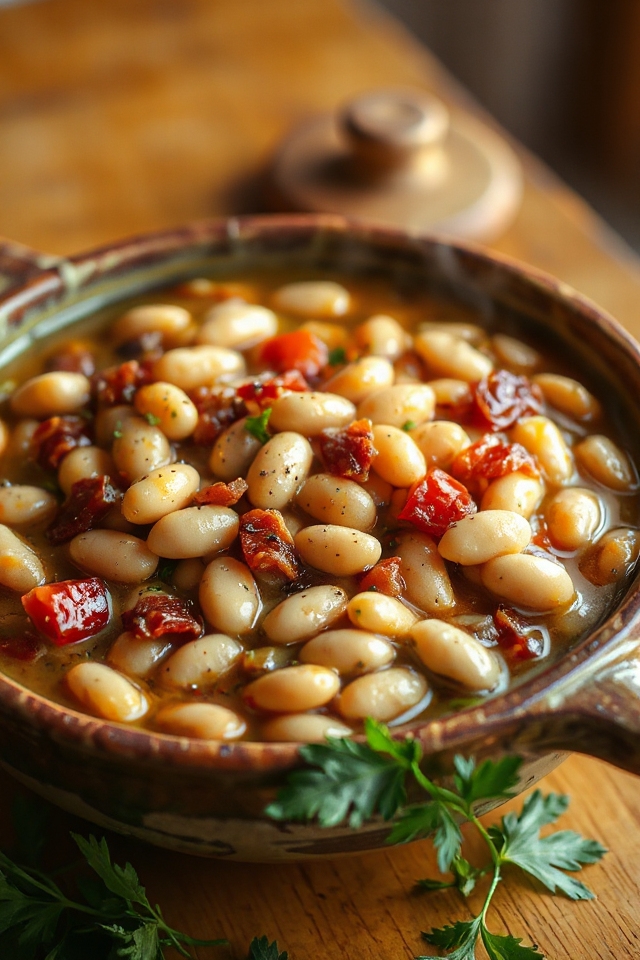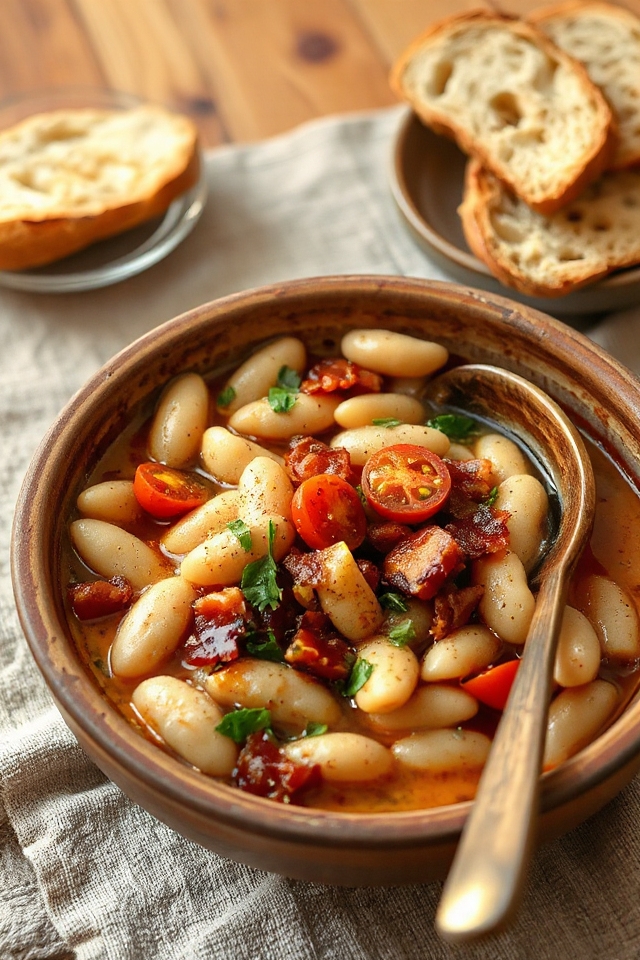Why You’ll Love this Slow-Cooked White Beans Recipe
When you plunge into this Slow-Cooked White Beans recipe, you’ll discover a hearty dish that’s perfect for any occasion.
I love how the combination of flavors melds together, creating a comforting and satisfying meal. The rich, smoky bacon pairs beautifully with the tender beans, while the depth from the spices elevates it to something truly special.
It’s so easy to make, letting you relax while it cooks. Plus, it fills your kitchen with an irresistible aroma that draws everyone in.
Whether it’s a family dinner or a get-together with friends, this dish always leaves everyone asking for seconds.
Ingredients of Slow-Cooked White Beans
When it comes to making Slow-Cooked White Beans, the ingredients are really the backbone of the dish. You’ll want to gather a few key items that not only add flavor but also create a hearty, filling meal.
There’s something incredibly satisfying about using simple, wholesome ingredients that come together to make something truly delicious. So, let’s jump into what you’ll need to whip up this incredible dish.
Ingredients for Slow-Cooked White Beans:
- 3/4 lb dried great northern beans, cleaned
- 1/2 lb bacon, diced
- 1 cup chopped yellow onion
- 1/4 teaspoon cayenne pepper
- 1 teaspoon cajun seasoning
- 1 1/2 teaspoons salt
- 1/2 teaspoon ground black pepper
- 1 (14 1/2 ounce) can chopped tomatoes, with the juice
- 1 (12 ounce) bottle lager beer or ale
- 1/2 cup dark molasses
- 1/2 cup packed light brown sugar
- 1/2 cup chicken stock
- 1/2 cup Canadian rye whisky
- 2 tablespoons whole grain mustard
- 1 tablespoon Worcestershire sauce
- 2 bay leaves
Now, before you rush out to the store, there are a couple of things to think about.
First off, the choice of beans is important; great northern beans are perfect for this recipe, but if you only have pinto or cannellini beans, they’ll work too—just keep in mind the cooking times might vary slightly.
And let’s not forget about the bacon; you can use regular or even turkey bacon if you’re looking for a lighter option. However, don’t skimp on the flavor—this dish thrives on that smoky goodness!
Finally, for the beer, if you’re not a fan, you can substitute it with extra chicken stock, but the beer really adds a depth that’s hard to replicate.
How to Make Slow-Cooked White Beans

Alright, let’s plunge into the delicious world of Slow-Cooked White Beans. First things first, you’ll want to grab your 3/4 lb of dried great northern beans. Rinse them off and then toss them in a big pot, covering them with water by about three inches.
Now, bring that pot to a boil. Once it’s bubbling away like a hot spring, reduce the heat to medium-low and let those beans simmer away, covered, stirring occasionally. You’ll want to keep an eye on them until they’re just tender, which usually takes about 1 hour and 20 minutes. Once they’re ready, drain them and set them aside, feeling proud that you’ve already conquered the first step.
Next up, we’re going to bring in the flavor with 1/2 lb of diced bacon. Cook that over medium-high heat in a large pot until it’s nice and brown, about six minutes. The smell of sizzling bacon is sure to make your kitchen feel like home.
Add in 1 cup of chopped yellow onion, 1/4 teaspoon of cayenne pepper, 1 teaspoon of cajun seasoning, 1 1/2 teaspoons of salt, and 1/2 teaspoon of ground black pepper. Stir that all together and cook it until the onion is soft—about four minutes should do it. Don’t forget to toss in some minced garlic for the last 30 seconds of cooking, because who doesn’t love the aroma of garlic wafting through the air?
Once that’s done, add in a 14 1/2 ounce can of chopped tomatoes (with all the juice), and let it simmer for a couple of minutes.
Now comes the fun part—let’s mix it all together! Pour in a 12-ounce bottle of lager beer (or ale, if that’s more your style), then add 1/2 cup of dark molasses, 1/2 cup of packed light brown sugar, 1/2 cup of chicken stock, 1/2 cup of Canadian rye whisky, 2 tablespoons of whole grain mustard, 1 tablespoon of Worcestershire sauce, and 2 bay leaves.
Stir that all together like you’re mixing a potion for deliciousness. Bring this concoction to a boil, then add your reserved beans back into the pot. Lower the heat to medium-low, cover it, and let it simmer for about an hour, stirring occasionally.
After this hour, remove the lid and let it simmer a bit longer—about 30 minutes to an hour—until everything is tender and the flavors have mingled beautifully. Don’t forget to adjust the seasoning to your taste before serving. It’s like a warm hug in a bowl, and trust me, you’ll be glad you took the time to make it.
Slow-Cooked White Beans Substitutions & Variations
While diving into the world of Slow-Cooked White Beans, you might find yourself wanting to mix things up a bit.
For a vegetarian twist, swap the bacon for smoked paprika or liquid smoke to maintain that rich flavor. You can also use vegetable broth instead of chicken stock.
If you’re feeling adventurous, try adding different vegetables like bell peppers or carrots for extra texture. For a spicy kick, toss in jalapeños or use a spicier seasoning blend.
Don’t forget to experiment with various types of beans, like cannellini or navy beans, to discover your favorite combination!
What to Serve with Slow-Cooked White Beans
Serving Slow-Cooked White Beans can be a delightful culinary experience, and there are plenty of options to complement their rich, savory flavor.
I love pairing them with crusty bread or cornbread to soak up the delicious sauce. A simple green salad with a tangy vinaigrette adds a revitalizing contrast.
For a heartier meal, grilled sausages or roasted chicken work beautifully alongside. If you’re in the mood for something extra, a dollop of sour cream or a sprinkle of fresh herbs can elevate the dish.
Whatever you choose, these sides will enhance your enjoyment of the beans!
Additional Tips & Notes
To guarantee your slow-cooked white beans turn out perfectly, I recommend soaking the beans overnight before cooking them. This not only reduces cooking time but also enhances their texture.
While cooking, keep an eye on the liquid level; add more water if it gets too thick. For extra flavor, feel free to toss in a few garlic cloves or herbs like thyme or rosemary.
If you want a spicier kick, adjust the cayenne pepper to your taste. Finally, don’t forget to taste and adjust the seasoning before serving—it’s all about finding that perfect balance.
Enjoy your delicious creation!
